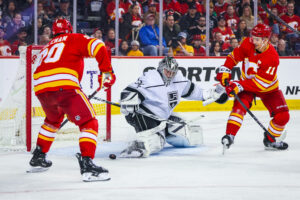Since Josh Norris started his pro career in 2019, he has won the Rookie of the Year in the AHL, has finished fourth in Calder voting for Rookie of the Year last season in the NHL, and currently leads the Ottawa Senators in goals this season with 18 in 32 games. He is undoubtedly the team’s number one center. He’s been able to find great chemistry with linemates Brady Tkachuk and Drake Batherson. Both Tkachuk and Batherson were recently signed to long-term deals. Thomas Chabot, the team’s best defenseman, is also signed long-term. It seems obvious that Norris, a restricted free agent at the end of this season, is next in line to be offered a long-term contract by the Senators. The question is, what will that deal look like?
Using Comparables to Project a Josh Norris Contract
The reality is, it’s impossible to perfectly predict a Josh Norris contract. There are still 49 games to play this season. It doesn’t seem too difficult, though, to project approximate numbers. There are some young forwards that signed contracts after their entry-level deals in recent years that make for good comparables. Josh Norris has shown growth each year as a pro, so it would be surprising to see him fall flat in the second half of the season. In this article, player comparables will be made to try to find out what Norris’ next deal could look like.
Comparing Norris to Batherson and Tkachuk
A good starting point for Norris’ next contract is an understanding that it should come in higher than Drake Batherson’s six-year, $4,975,000 AAV contract, but lower than Tkachuk’s seven-year, $8,205,714 AAV deal. Those two deals took up 6.1% and 10.07% of the team’s salary cap. It’s obvious why Norris will end up with a deal worth less than Tkachuk’s. Tkachuk played three full seasons before signing his contract, scoring 60 goals and 125 points. During that time, he was also one of the most physical players in the league, and the team’s leader. Even if Norris stays healthy and productive through the end of this season, his numbers and impact won’t quite approach what Tkachuk was able to accomplish during his entry-level deal.
While some might think that Batherson’s deal makes for a good starting point for Norris’ next contract, a quick look at the numbers suggests that Norris should be able to ask for more. Before signing this past summer, Batherson had played in 99 games, scoring 23 goals and 53 points. Batherson spent most of his first two seasons as a pro in the AHL. The advantage Norris has is that he only needed one AHL season. That gives him two full seasons in the NHL to try to up the value on his next deal. Even with 49 games still to play this season, he’s already scored twelve more goals and eight more points than Batherson did by the end of last year, doing so in eight fewer games.
Focusing on Comparing Cap Hit Percentages
Given all this information, it seems obvious that Norris’ next contract should be higher than 6%, but lower than 10% of the cap. It should also be noted that the NHL’s Salary Cap is set to go up by one million dollars next season, to $82.5 million.
Bettman reiterated the salary cap will go up $1M next season. Which was agreed to before.
— Pierre LeBrun (@PierreVLeBrun) December 10, 2021
The best number to look at when making comparisons is the percentage of the cap for each contract. While there is not a perfect comparison to be made, there are a few young players with similar production to Norris who signed deals with their teams not too long ago. Let’s also keep in mind that while General Manager Pierre Dorion does seem intent on locking in his young core for the long term, sometimes that long-term deal can’t be worked out, and the team has to settle for a bridge contract.
[pickup_prop id=”19122″]
Reasons for a Bridge Contract
The advantage of a bridge deal is obvious for teams with cap concerns. It allows teams to lock in their young talent for a few years without having to pay huge dollars. This means they can continue to afford other players on their team. It also makes sense when teams are not convinced about a young player truly being a core piece. The Senators have a ton of cap space. It’s also obvious that Norris is an important player for them moving forward. To settle on a bridge contract would be a disappointment. You can’t rule out the possibility, though. In terms of who’s contract makes for a good comparison if they had to opt for a shorter contract, Brock Boeser of the Vancouver Canucks makes sense.
Short Term Contract Comparable
Boeser jumped right into the NHL after two seasons at the University of North Dakota. His stats while on his entry-level deal were 140 games with 59 goals and 116 points. Norris has played 91 games with 35 goals and 61 points. What’s interesting is that if Norris can stay healthy and continue to produce at the same level as he has through the first part of this season, his career numbers would be 140 games, 62 goals, and 101 points. Those numbers are not too far off from what Boeser accomplished.
Boeser was able to earn a three-year, $5,875,000 AAV deal in September of 2019. That was good for 7.21% of the salary cap at that time. Boeser didn’t spend any time in the AHL so it’s not a perfect comparison. Still, it would be reasonable, with a solid second half, for Norris to point to this contract as a short-term option between him and the Senators. For the Senators, though, this would be a less than desirable contract. They have a plethora of space and a preference to sign their young core to long-term deals. As far as what a longer deal could look like, Filip Forsberg of the Nashville Predators makes for a good comparable.
Six-Year Contract Comparable
Forsberg showed promise as an AHL player, scoring 34 points in 47 games. The next two seasons were both in the NHL. He scored 63 and then 64 points in back-to-back 82 game seasons. In total, he scored 133 points in 182 games on his entry-level contract. Like Norris, he finished fourth in Calder voting as a rookie. His 0.73 points per game on his entry-level deal is slightly higher than Norris’ current NHL points per game, which sits at 0.67.
Forsberg received a six-year, $6,000,000 AAV contract, good for 8.22% of the cap. Given these comparisons, it would seem fair for Norris to accept a six-year contract worth over 8% of the salary cap. There are, however, a few young players who in recent years, received much bigger deals than the ones mentioned above. That is something Norris’ side might try to push for.
Eight Year Contract Comparables
Nick Suzuki of the Montreal Canadiens signed an eight-year deal worth 9.67% of the cap this past summer. Jack Hughes of the New Jersey Devils signed an eight-year deal worth 9.82% of the cap at the end of November. The key to those players being signed to such high percentages of the salary cap was that they accepted eight-year contracts, keeping them under team control for the maximum years allowed. They also all signed after just two full seasons, and they were regulars in the NHL younger than Norris was.
If Norris signs for the full eight years, it might be tough for him to sign for exactly what Hughes and Suzuki did, but if he continues to produce well in the second half, he shouldn’t be too far off. With all the comparisons made above, it’s now time to make reasonable predictions for Norris’ next deal.
[pickup_prop id=”9760″]
Norris’ Next Contract by the Numbers
A shorter three-year contract for Norris should take up about 7.15% of the cap. With a salary cap of $82.5 million next year, that would be a three-year, $5,900,000 AAV contract. With this type of contract, you can expect the last year of the deal to be worth over $7,000,000. That way Norris can expect a high qualifying offer in a few years’ time.
If the two sides end up coming together on a six-year deal, it should take up around 8.15% of the cap. That would be a six-year $6,725,000 AAV contract. This would set Norris up to hit free agency at 29 years old.
If they ended up with a full-length, eight-year deal, it would likely take up around 9% of the cap. That would be an eight-year, $7,400,000 AAV deal.
Ideally, the Senators will be able to sign Norris to a six, seven, or eight-year contract. He has been the Senators’ top center for most of his time with the team, and his good production as a rookie has further progressed this season. Locking him in long term would be another step in the right direction for the Senators organization.
Main Photo:






